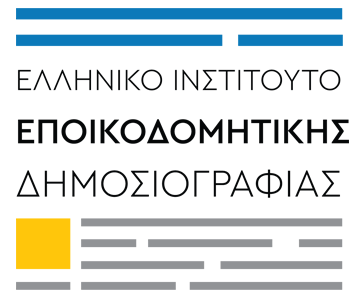Ελληνικό Ινστιτούτο Εποικοδομητικής Δημοσιογραφίας
ΤΙ ΠΕΡΙΛΑΜΒΑΝΕΙ
Η Εποικοδομητική Δημοσιογραφία (Constructive Journalism) είναι ένας γενικός – περιεκτικός όρος (ένας όρος ομπρέλα). Υπάρχουν πολλοί παρόμοιοι όροι, όπως η Δημοσιογραφία των Λύσεων (Solutions Journalism), η Δημοσιογραφία Προοπτικής (Prospective Journalism: Δημοσιογραφία που εστιάζει στο μέλλον -προέρχεται από τη σχετικά νέα έννοια στην Ψυχολογία της προοπτικής, η οποία αναφέρεται στη νοητική αναπαράσταση και την αξιολόγηση πιθανών μελλοντικών καταστάσεων), η Ειρηνευτική Δημοσιογραφία (Peace Journalism) και η Επανορθωτική Αφήγηση (Restorative Narrative Journalism). Ουσιαστικά, όλοι, αποτελούν κλάδους της Εποικοδομητικής Δημοσιογραφίας. Θα μπορούσαμε, επιπλέον, να συμπεριλάβουμε εδώ και τη λεγόμενη «αργή» δημοσιογραφία (Slow Journalism) – έναν επιμέρους τομέα που γεννήθηκε και αυτός από την απογοήτευση για την ποιότητα της καθιερωμένης (mainstream) δημοσιογραφίας. (Περισσότερα πάνω στους διάφορους όρους/είδη δημοσιογραφίας που «υπερβαίνει τα προβλήματα», μπορείτε να βρείτε στο Βιβλίο της Karen McIntyre και Nicole Damen “Reporting Beyond The Problem: From Civic Journalism to Solutions Journalism”.)
Κλάδοι Εποικοδομητικής Δημοσιογραφίας
Πηγή: Dr. Karen McIntyre
Γενικά, η Εποικοδομητική Δημοσιογραφία στοχεύει στη βελτίωση της ατομικής και κοινωνικής ευημερίας. Αποτελεί απάντηση στην αυξανόμενη σκανδαλοθηρία, τον εντυπωσιασμό και την αρνητική προκατάληψη των σημερινών μέσων ενημέρωσης. Περιλαμβάνει μια προσέγγιση της ενημέρωσης που εστιάζει στις λύσεις, κατά την οποία οι δημοσιογράφοι δεν επικεντρώνονται μόνο στα προβλήματα. Αντί να ερευνούν απλώς τι πηγαίνει στραβά στον κόσμο, διερευνούν και τι πηγαίνει σωστά – και γιατί. Εμπλουτίζει τόσο την έκτακτη όσο και την ερευνητική δημοσιογραφία. Όχι λέγοντας «χαρούμενες» ιστορίες ή μειώνοντας την ευαισθητοποίηση του κοινού απέναντι στα προβλήματα, αλλά, ενημερώνοντάς το πληρέστερα για το τι συμβαίνει γύρω από ένα συγκεκριμένο ζήτημα, παρουσιάζοντας καλές πρακτικές ανθρώπων/χωρών/ πολιτικών που το αντιμετωπίζουν αποτελεσματικά.
Από ένα τέτοιο είδος Δημοσιογραφίας μπορούν να προκύψουν πολλά οφέλη: αυξημένη δραστηριοποίηση του κοινού, υπευθυνότητα για εκείνους που χαράσσουν πολιτική και μια πιο ολιστική άποψη του κόσμου. Αλλά, όλα, ξεκινούν από την ενημέρωση των ανθρώπων…
Η Δημοκρατία χρειάζεται ισχυρή, ανεξάρτητη, κριτική δημοσιογραφία. Η πληρέστερη ενημέρωση των ανθρώπων μπορεί να τους ενεργοποιήσει, ώστε να γίνουν «ισχυροί συντελεστές μιας συμμετοχικής δημοκρατίας».
Οι Τρείς Πυλώνες της Εποικοδομητικής Δημοσιογραφίας, Πηγή: Constructive Institute
Η Εποικοδομητική Δημοσιογραφία είναι σημαντική όχι μόνο για τη βιομηχανία των ειδήσεων, αλλά για τη Δημοκρατία και όλους μας. Στο παρακάτω βίντεο εξηγούνται οι Τρεις Πυλώνες που περιγράφουν τις τρεις προσεγγίσεις της εποικοδομητικής δημοσιογραφικής πρακτικής, οι οποίες προσφέρουν ένα συμπλήρωμα τόσο στην έκτακτη όσο και στην ερευνητική δημοσιογραφία. Αποτελούν το θεμέλιο της Εποικοδομητικής Δημοσιογραφικής πρακτικής. Κάθε πυλώνας αντιπροσωπεύει μια δημοσιογραφική προσέγγιση και, όλες μαζί, τροφοδοτούν την κύρια αποστολή που είναι η συμβολή στη Δημοκρατία. Δεν πρόκειται όμως απλά για ένα μοντέλο. Αποτελούν το λεξιλόγιο για να συζητάμε περί Εποικοδομητικής Δημοσιογραφίας και του τρόπου άσκησής της.
Εξερευνήστε τη «Βιβλιοθήκη» μας για να μάθετε περισσότερα για την Εποικοδομητική Δημοσιογραφία, από ενημερωτικά βίντεο μέχρι περαιτέρω βιβλιογραφικό υλικό.
Τι είναι και τι δεν είναι εποικοδομητική δημοσιογραφία
Η λεγόμενη «Θετική Δημοσιογραφία» δεν είναι ταυτόσημη με την Εποικοδομητική (γι’ αυτό και απεικονίζεται χωριστά στην παραπάνω εικόνα με τους κλάδους). Είναι λιγότερο σοβαρή ή απαιτητική και συχνά αφηγείται ιστορίες ηρώων και μεμονωμένων γεγονότων που δεν έχουν ουσιαστική σημασία για την κοινωνία – αλλά, αυτό, δεν σημαίνει ότι αυτές οι ιστορίες δεν έχουν χρήσιμο ρόλο. Μερικές φορές η διάκριση μπορεί να είναι ασαφής.



